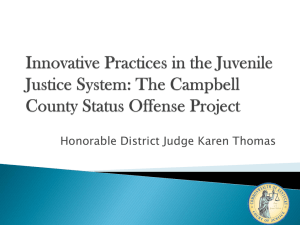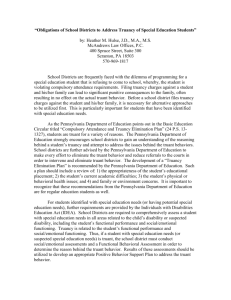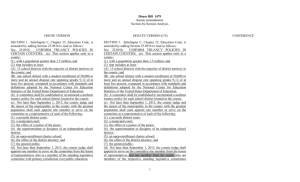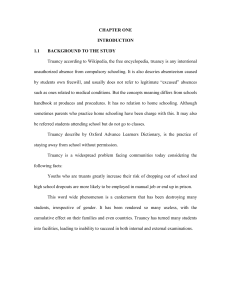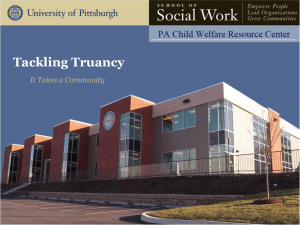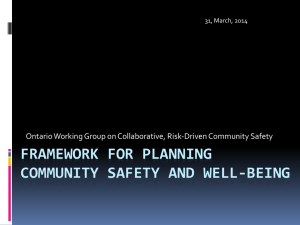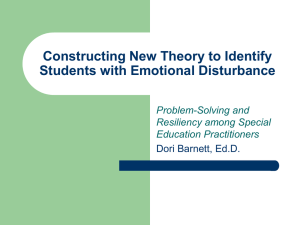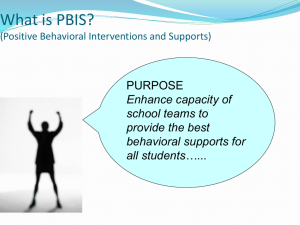Team 2
advertisement
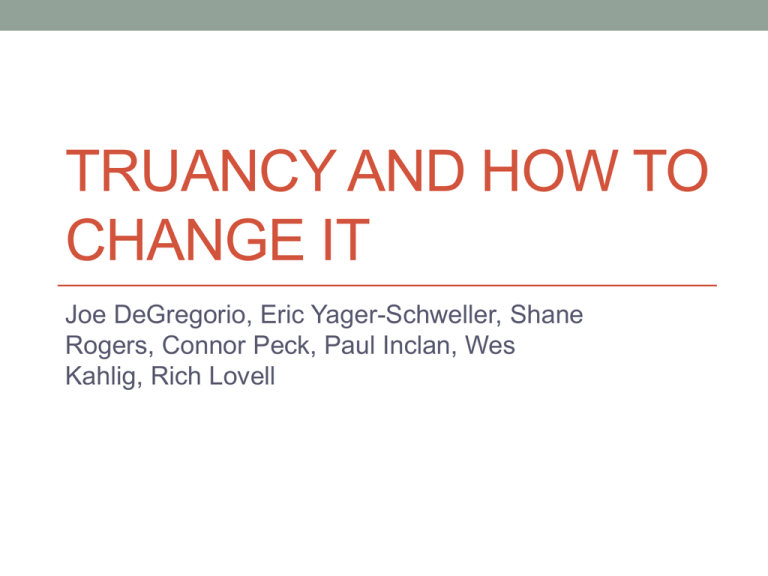
TRUANCY AND HOW TO CHANGE IT Joe DeGregorio, Eric Yager-Schweller, Shane Rogers, Connor Peck, Paul Inclan, Wes Kahlig, Rich Lovell 2 American Education vs. World • Organisation for Economic Co-operation and Development (OECD) • Surveyed kids at age 15 from various countries belonging to OECD • Of 30 nations studied, US ranked 21st in scientific literacy, 25th in mathematics literacy, and 24th in problem solving skills 3 In Search of Academic Improvement… • In 2001, George W. Bush introduces No Child Left Behind Act (NCLB) • In regards to truancy: effective in 2005-2006, each state must report truancy rates for all public institutions • Problem with analyzing truancy statistics nationally is lack of uniformity in laws from state to state 4 New Approaches • Analysts correlate truancy to various poor behaviors, but finding studies that can properly support their theories is difficult • National Center for School Engagement (NCSE) suggests ways to better define the prevalence of the problem • NCES Longitudinal Data • NCES Common Core of Data • Juvenile Justice Statistics in Truancy Court • A Sampling of Large School Districts from across the country 5 Conclusions • Each effort of NCSE came with its own pros and cons • It is evident that the US has a problem with truancy, and it is highly likely that this problem plays a role in the nation’s academic standing relative to other advanced countries • Putting accurate numerical values on the pervasiveness of truancy and judging its direct consequences on US test taking is the difficult part 6 Federal Government • Doesn’t create specific legislation concerning truancy •Only provides guidelines through the Department of Education 7 Ohio Revised Code: Definitions • Habitual Truant • Ohio Revised Code 2151.011 • “any child of compulsory school age who is absent without legitimate excuse for absence from the public school the child is supposed to attend for five or more consecutive days, seven or more school days in one school month, or twelve or more school days in a school year.” • Chronic Truant • Ohio Revised code 2152.02 • “any child of compulsory school age who is absent without legitimate excuse for absence from the public school the child is supposed to attend for seven or more consecutive school days, ten or more school days in one school month, or fifteen or more school days in a school year.” 8 Ohio Revised Code: Mentions of Truancy • Ohio Revised Code 3301-47 • Establishes an education program for the parents of truant students • Ohio Revised Code 2152.02 • Definition of Delinquent children • Ohio Revised Code 2151.011 • Juvenile court definitions 9 Causes of Truancy • Costs of truancy are high • Imperative to understand root causes • Three main contributing factors: 1. Family/Community 2. School 3. Student 10 Causes: Family Factors • Poor parent involvement • Lack of supervision • Poverty • Violence (examples): ◦ Substance abuse ◦ Lack of awareness ◦ Attitude towards education • Parenting involvement dictates: • Child’s academic abilities • Attendance and completion rates • Overall school performance 11 Causes: Community Factors • Unsafe or unsupportive communities • High rates of child-self care • Lack of responsiveness to truancy • SES – Relative standing in society • Related to income, background, power, and prestige • Children with low SES have higher rates of truancy 12 Causes: School Factors • School Procedures • Ineffective policies • Poor record keeping • Failure to notify parents • School Environment • Safety – violence and bullying • Comfortable surroundings ◦ Staff relations ◦ Inadequate educational needs 13 Causes: Student Factors • Student Involvement • Substance abuse • Educational ambition • Socially integrate • Mental/Physical limitations • Poor student involvement: • Risk of exclusion • Delinquent activities 14 Consequences • State Legislature and the education laws are determined by the state • No Child Left Behind Act- Requires schools and districts to report attendance rates 15 Consequences • Law enforcement departments must decide whether to pick up truants and what to do with them • Court System decides • Which court will hear the truancy case • Whether to hold a separate truancy docket • How to achieve consistency in sentencing among judges • What sanctions to employ • Whether and what kind of alternative truancy reduction program to offer 16 Students Consequences • Can be fined anywhere from $250 to $5000 depending on the state and the court • Some states also have the power to take away the drivers license of the student • Students can also be sent to diversion classes or to community service • It is believed that truants are more likely than other students to end up in juvenile and the adult criminal justice system 17 Parental Consequences • Depends on the age of the student, state of residence, and the court philosophy • Most often include fines, orders to attend school with children, or parenting class • Extreme cases parents may face dependency or neglect charges, lose custody of their children, or face jail time 18 School Policy on Truancy • Most all schools have some written strategy that addresses attendance problems • Policies may differ, but some of the recurring themes are: • School must provide truancy intervention and counseling for student (parents, guardians, caretaker optional) • School must identify the truant to the Bureau of Motor Vehicles • School must take legal action against the truant’s parents, guardians, caretaker 19 Contra Costa County, California • Decided to implement truancy program at the elementary school age • School officials would checkup on any unexcused absences • Way to monitor the child’s actions, offer connection back to school life • Beneficial to address truancy earlier rather than later 20 Mesa, Arizona • Decided to send recurring truants to juvenile count and charge with a crime • High school truancy officials track student’s truancy • Punishment: typically a fine, community service, or suspension of driving license • Found to be very effective, more expensive 21 • Elementary school intervention • Truant behavior is not ingrained • Parent still has control over child • Can be held more accountable • High school intervention • Requires harsher punishments, more expensive strategies to get same point across 22 Solutions • Family Solutions • School Solutions • Community Solutions • Government Solutions 23 Family Solutions • Increased enforcement amongst parents • Positive role models • Increased awareness • Increased importance of school 24 School Solutions • Stiff penalties for violators • Safe atmosphere • Quality faculty and staff • Fun and relevant classes 25 Community Solutions • Police enforcement • Responsible friends and family • Neighborhood Watch programs 26 Government Solutions • Uniform Laws • Strict enforcement and punishment • General safety improvement
